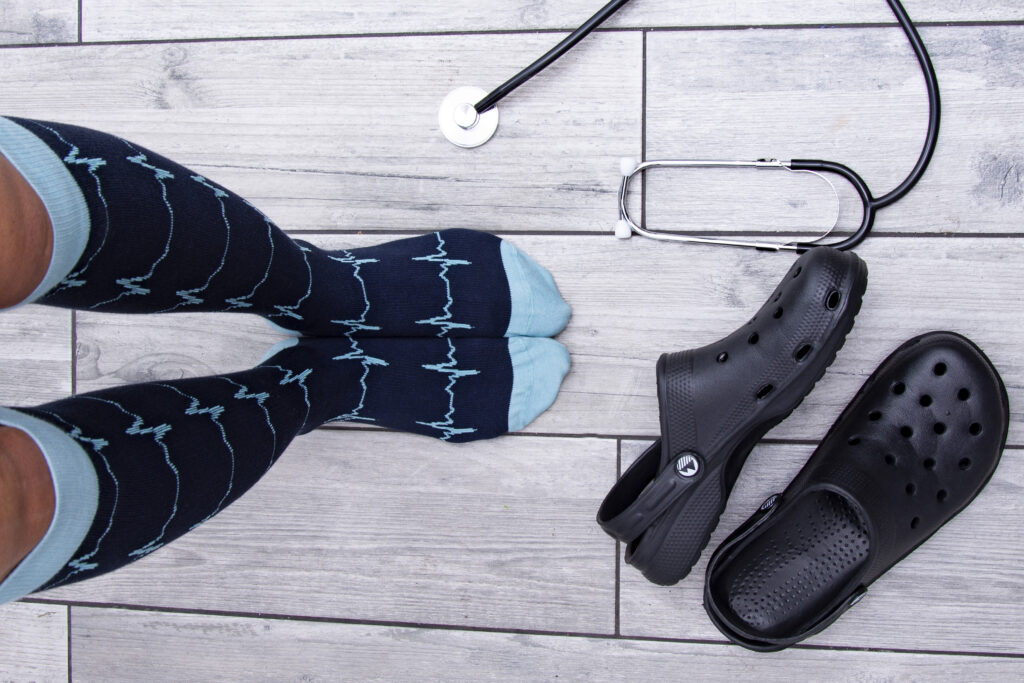Nursing is a demanding profession that requires long hours of standing, walking, and constantly being on your feet. It’s no surprise that many nurses experience discomfort and fatigue in their lower limbs. Luckily, there’s a simple yet effective solution: compression socks for nurses. More and more healthcare workers in the UK are turning to compression socks as a solution to their tired and achy legs. In this blog post, we will explore what compression socks for nurses are, their benefits, why nurses wear them, and how to choose the right pair.
What are Compression Socks for Nurses?
Compression socks are specialised hosiery garments designed to apply gentle pressure to the legs, ankles, and feet. They are typically made of elastic materials such as cotton or bamboo fibres that provide graduated compression, meaning the pressure is highest at the ankle and gradually decreases towards the calf and thigh. The socks come in various lengths, styles, and compression levels, catering to individual needs.
It has been a long-standing practice for compression therapy to be used for a variety of reasons within the healthcare setting. However, it is a more recent phenomenon for healthcare workers to apply low-to-mild compression to improve their leg health and the way they feel at work.
Comfortable, warm and stylish, the right pair of nurses’ compression socks will help you get through your shift, with less of a toll on your legs.
What Are The Benefits of Compression Socks For Nurses?
Compression socks offer numerous benefits for doctors, nurses and other medical professionals beyond just being a fashionable accessory. Here are some of the advantages of nurses compression socks:
- Improved blood circulation: The graduated compression provided by compression socks helps promote better blood flow by assisting the veins in pushing blood back towards the heart. This reduces the risk of blood pooling in the lower extremities, making the wearer feel fresher and more energised.
- Reduced swelling and oedema: Nurses can experience swelling in their legs and feet due to prolonged periods of standing, walking or sitting. Compression socks can alleviate this discomfort by preventing fluid buildup, reducing oedema, and facilitating lymphatic drainage.
- Enhanced muscle support: The compression offered by these socks provides support to the calf muscles, reducing muscle fatigue, and minimising the risk of leg cramps or shin splints.
- Increased energy and decreased fatigue: By improving circulation and reducing swelling, compression socks can help nurses feel more energised throughout their shifts. This also has a positive effect outside of work, helping to feel better after long shifts.
Why do nurses wear compression socks and how do they help?
Nurses wear compression socks primarily to combat the challenges posed by their physically demanding jobs. Here’s how compression socks benefit nurses specifically:
- Alleviating leg pain and fatigue: Prolonged standing or walking can lead to achy, fatigued legs. Compression socks provide relief by stimulating blood flow and reducing muscle vibration, thereby minimising discomfort.
- Helping to prevent varicose veins: Nurses are at a higher risk of developing varicose veins due to the nature of their work. Compression socks help maintain vein integrity and prevent the appearance of these unsightly and potentially painful varicose veins.
- Mitigating the risk of blood clots: Long shifts without much movement can increase the risk of deep vein thrombosis or blood clots. Compression socks promote healthy circulation, reducing the chances of clot formation.
- Looking awesome: If you get the right brand for you and your uniform policy. You can stand out and show your personality through your compression socks! FITLEGS Life compression socks come in a range of stylish and fun designs to suit any taste. It’s not just for nurses either, anybody who spends a lot of time on their feet for work or leisure can benefit from wearing compression socks.
How to choose the right compression socks:
When selecting compression socks, consider the following factors:
Compression level: Compression socks come in different levels of pressure, ranging from mild to extra firm. The appropriate level depends on your specific needs. So, consult with a healthcare professional to determine the right compression strength for you.
Size and fit: Proper sizing is crucial for the effectiveness and comfort of compression socks. Measure your legs accurately, following the manufacturer’s guidelines, to ensure a snug fit without being overly tight.
Length and style: Compression socks are available in various lengths, including knee-high, thigh-high, and pantyhose-style. Choose a length that suits your preference and offers the desired level of support.
Ensuring the right size:
To ensure the right size of compression socks, follow these steps:
a) Measure your legs: Use a measuring tape to measure the circumference of your ankle and calf at the widest points.
b) Determine your size: Compare your measurements to our size chart.
c) Try them on: Once you have your size, try on the socks to ensure a comfortable fit. The socks should be snug but not overly tight or restrictive.
Compression socks are an invaluable accessory for nurses, doctors, carers and other medical professionals, providing support, reducing discomfort, and promoting better leg health. By improving circulation, mitigating swelling, and preventing potential complications, compression socks play a vital role in ensuring the well-being of nurses during demanding shifts. So, invest in a quality pair of nurses’ compression socks today and let them be your feet’s best friend throughout your nursing career.
